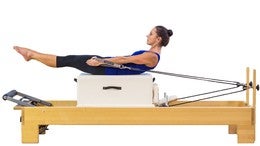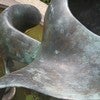Description
About This Video
Transcript
Read Full Transcript
Hi, welcome back. So glad y'all could be here. And I'm here today with Jennifer. It's great to be with you. We're going to be exploring backstroke on the reformer and we have mister bones here with us because he's got a certain little setup here. You see set up is everything, how we set ourselves up in relationship to gravity and what do we mean by that? What is actually, um, allowing the tension that I normally start with to ease.
How can I let myself ease into a relationship with the box on the reformer so that the effort is just enough for the movement. So this is really powerful and you'll see as we build it. So let's look just a second at a, at some of the therabands that we have on Mr Bones, first of all, the green theraband is the lift from inner ankle through the inner thigh. Not really along the front of the front of the leg, but we wanted to keep it on so you could feel it. You could sense that it's the back of the leg. So inner ankle, inner side, back of the leg, hamstrings along the front of the spine, through the front of the pelvic floor to the inner ear. That's list.
This is natural, but the only way that happens is there has to be grounding. There has to be a release down. And that happens. True. The front widening of the clavicles and you'll see how I'm working with Jen that I'm going to say soft eyes. Soft eyes means seeing the sides of the room. This is how children see peripheral vision that gives us our lateral body. Cause lateral gives me lift. When you're able to feel your whole foot, when you're able to feel your whole hand, when you soften your eyes, everything lifts and is natural. It's amazing.
So that starts here. The widening widening, the clavicles beautiful. You see how just that field, it just feels great to your body. You're sensing your natural relationship to gravity and it's really stunning how your body responds to give you more with less effort. So the widening of the clavicles begins the waterfall down the back, and the waterfall is the shoulder blade water falling down through the spine, through the tail, through the back of the leg. Again, through the tribal attitudes to the tripod of the foot. So the down how Jennifer's going to lie down on the box and not try to hold herself with her stomach is going to shift her relationship to backstroke. So let's take a look. You'll notice that first of all, we're beginning with weights.
So why are we starting with weights? So go ahead and lie down and [inaudible] say a little something about what you're noticing about just holding the weight. It's having her feel more centered. And notice that her shoulder blades are water falling down to the back of her arm is connected to her internal lift. So let your head rest back in my hand just a little bit, Jen and right, right.
So this is a distinction to notice. How heavy are the weights? What's heavier, what weight? A two pound three pound actually talks to your body because the purpose of the weight is to ground the spine. To Open your back when you open your back. Now from there, just keep your knees bent for a moment. Open your arms out, up, open around, and our reach your legs to me.
And as you reach your legs to me, put your feet against me and feel the lift and see how the waterfall down and the reach is giving you more shoulder blade to deep belly. Beautiful than your elbows. And come back in. Right. So here's the lift, the grounding shoulder blade, sit bone, tailbone into the tripod of the foot was the reach going out open. Circle around and bend your knees and feel the waterfall down. Feel even more. Drop your shoulders more, more, more yes.
And see how that gives you more lift here. Right? Do that again. Up Open. And, and as you come back in, feel the down the back gives you lift up the front, right. And then lie back down. Yes. Yeah. And go all the way back down. Good. Great. Okay, so the big thing that we're really looking at right here is how does your back open for one thing, if you pull your belly in first, this is a real distinction that we're studying and noticing the difference between if you pull your belly in first, your back hardens. When you relax into gravity, when you allow your back to open first by releasing into gravity, and then let your exhale draw the belly in and up to follow the diaphragm, which is a more natural way of feeling the scoop. Then what that does is it keeps your back open. Makes Sense.
So rather than core control hardening, we look at core coordination. How do our abdominals connect with the arms, the legs, the rooting? How are arm routes to set or how our legs route to center. And let's look at this for just a second. How does the red theraband connect with the way the diaphragm works with the movement of the diaphragm?
So your leg connects through to the front of your spine and to your diaphragm. So when you route from, allow the gravity to open your back. And then as you exhale, your arms and your legs connect to center on the exhale. What that does is it keeps your back open, it connects, and it actually allows your head to curl with less tension in your neck. So this is a huge thing. How does the diaphragm route into the spine and how does the spine connect to the leg? Beautiful.
So let's now take this with the straps and see what you notice. Inhale, open and back in. So reached to me as you send the arms right now, how does the straps feel like the weights they ground me feeling more supported, open around. So I'm asking Jennifer how the strap is connecting with her body, like the weight had connected, which is really the distinction that we want to sense is how does the back of your arm connect to the waterfall and to the internal support. How does your breath opening and widening your back ground you to center?
So everything arms, head, leg connect to center on the exhale, inhale opens, exhale, and everything comes back in right? Let's feel it again. So feel the connection of the back of your arm to the right. Inhale to go out, open and right. I'll say, forward. Forward, forward, forward, yes. And ouch.
Out. Open and good. Now this time reverse goes straight out, out open and stay forward. Forward, forward as you bring 'em in, right and out, out open and safe. Forward as until the back of your arm connecting. And last one. Inhale out. Open.
Exhale and stay in and lie back down. Yeah. Beautiful. Yeah. So the main thing that we're studying with how we're doing, what we're doing is [inaudible]. What does it feel like in your body? You know, we haven't, we don't really examine that a lot. I think that we've learned so much about our bodies.
We've learned so much about, um, just what is the fashionable connection. We didn't know anything about the Fascia and Joseph [inaudible] lifetime. We didn't know that Fatia supports muscles, bones, organs, and how that creates a, a more sense of ease in the body. It also really relaxes your nervous system. When we use the whole body in relationship to gravity, we're actually grounding the nervous system.
So it's a way to calm your mind. It's a way to bring yourself back to a more centered way of thinking about just life in general. And it's a very powerful, powerful distinction for us to study in pilates as clients and as teachers. What are we doing? How are we, how are we understanding the brilliance of this work? And yet, how are we continuing to develop a way of being that's updating our understanding of how to help ourselves? Because we're not machines to be trained and fixed. We are deeply intelligent, brilliant organisms that know how to self heal.
We're adaptive and we are awesome. So thanks Jen. Beautiful. Be sure to watch our teaser tutorial, which you're gonna see how we'll come from backstroke to teaser and help [inaudible] it gets built so fabulous together. See you soon.
Comments
everything makes sense and falls into place! I love your workshops, tutorials and classes, thank you !!!!
I'm new to teaching Pilates, but have been teaching Alexander technique for a few years. I instinctivly have shunted away from the whole "pull the abs in" rethiric of experiencing and teaching movement, and I can't tell you how truly wonderful it is to have my deep felt sense of my relationship to both teaching, learning and exploring 'sound movement' resounded in your way of teaching. The importance and the "how" of a "thing" is the most real distinction of learning how to teach ourselves with compassion, strength and enquiry. Of course FM Alexandr had the words, hands and vision to understand and relay that ease of movement comes from internal fluidity and is a continual process. Thanks and look forward to your upcoming videos!
You need to be a subscriber to post a comment.
Please Log In or Create an Account to start your free trial.
















